Surface Aerosol Properties Studied Using a Near-Horizontal Lidar
Abstract
1. Introduction
2. Weather and Aerosol Conditions in November 2017
3. Instruments and Methodology
3.1. Near-Horizontal Lidar
3.2. Visibility-Meter and Aethalometer
4. Results and Discussion
4.1. Lidar-Derived Total Extinction Coefficient
4.2. Correlation between Lidar and Visibility-Meter Data
4.3. Relation of Near-Surface αext to Atmospheric Boundary Layer Height
4.4. One-Month Variations of αext and SSA
4.5. Influence of Varying Sky Conditions and RH on Near-Surface αext and SSA
5. Conclusions
Author Contributions
Funding
Acknowledgments
Conflicts of Interest
References
- Climate Change 2013—The Physical Science Basis. Contribution of Working Group I to the Fifth Assessment Report of the Intergovernmental Panel on Climate Change; Cambridge University Press: New York, NY, USA, 2013; pp. 33–118. [Google Scholar]
- Hobbs, P.V. Aerosol-cloud interactions. In International Geophysics; Elsevier: Amsterdam, The Netherlands, 1993; Volume 54, pp. 33–73. [Google Scholar]
- Seinfeld, J.H.; Pandis, S.N. Atmospheric Chemistry and Physics: From Air Pollution to Climate Change; John Wiley & Sons: Hoboken, NJ, USA, 2016. [Google Scholar]
- Abbey, D.E.; Nishino, N.; McDonnell, W.F.; Burchette, R.J.; Knutsen, S.F.; Lawrence Beeson, W.; Yang, J.X. Long-term inhalable particles and other air pollutants related to mortality in nonsmokers. Am. J. Respir. Crit. Care Med. 1999, 159, 373–382. [Google Scholar] [CrossRef] [PubMed]
- Pope, C.A., III; Burnett, R.T.; Thun, M.J.; Calle, E.E.; Krewski, D.; Ito, K.; Thurston, G.D. Lung cancer, cardiopulmonary mortality, and long-term exposure to fine particulate air pollution. JAMA 2002, 287, 1132–1141. [Google Scholar] [CrossRef] [PubMed]
- Samet, J.M.; Dominici, F.; Curriero, F.C.; Coursac, I.; Zeger, S.L. Fine particulate air pollution and mortality in 20 US cities, 1987–1994. N. Engl. J. Med. 2000, 343, 1742–1749. [Google Scholar] [CrossRef] [PubMed]
- Dreischuh, T.; Grigorov, I.; Peshev, Z.; Deleva, A.; Kolarov, G.; Stoyanov, D. Lidar Mapping of Near-Surface Aerosol Fields. Aerosols-Sci. Case Stud. 2016, 85–107. [Google Scholar] [CrossRef]
- Maki, T.; Furumoto, S.; Asahi, Y.; Lee, K.C.; Watanabe, K.; Aoki, K.; Murakami, M.; Tajiri, T.; Hasegawa, H.; Mashio, A. Long-range-transported bioaerosols captured in snow cover on Mount Tateyama, Japan: Impacts of Asian-dust events on airborne bacterial dynamics relating to ice-nucleation activities. Atmos. Chem. Phys. 2018, 18, 8155–8171. [Google Scholar] [CrossRef]
- Nishizawa, T.; Sugimoto, N.; Matsui, I.; Shimizu, A.; Hara, Y.; Itsushi, U.; Yasunaga, K.; Kudo, R.; Kim, S.-W. Ground-based network observation using Mie–Raman lidars and multi-wavelength Raman lidars and algorithm to retrieve distributions of aerosol components. J. Quant. Spectrosc. Radiat. Transf. 2017, 188, 79–93. [Google Scholar] [CrossRef]
- Tsedendamba, P.; Dulam, J.; Baba, K.; Hagiwara, K.; Noda, J.; Kawai, K.; Sumiya, G.; McCarthy, C.; Kai, K.; Hoshino, B. Northeast asian dust transport: A case study of a dust storm event from 28 March to 2 April 2012. Atmosphere 2019, 10, 69. [Google Scholar] [CrossRef]
- Vaughan, M.A.; Powell, K.A.; Winker, D.M.; Hostetler, C.A.; Kuehn, R.E.; Hunt, W.H.; Getzewich, B.J.; Young, S.A.; Liu, Z.; McGill, M.J. Fully automated detection of cloud and aerosol layers in the CALIPSO lidar measurements. J. Atmos. Ocean. Technol. 2009, 26, 2034–2050. [Google Scholar] [CrossRef]
- Sasano, Y.; Shimizu, H.; Takeuchi, N.; Okuda, M. Geometrical form factor in the laser radar equation: An experimental determination. Appl. Opt. 1979, 18, 3908–3910. [Google Scholar] [CrossRef]
- Wandinger, U.; Ansmann, A. Experimental determination of the lidar overlap profile with Raman lidar. Appl. Opt. 2002, 41, 511–514. [Google Scholar] [CrossRef]
- Shimizu, A.; Sugimoto, N.; Matsui, I. Detailed description of data processing system for lidar network in East Asia. In Proceedings of the 25th International Laser Radar Conference, St. Petersburg, Russia, 5–9 July 2010; pp. 911–913. [Google Scholar]
- Satheesh, S.; Vinoj, V.; Moorthy, K.K. Vertical distribution of aerosols over an urban continental site in India inferred using a micro pulse lidar. Geophys. Res. Lett. 2006, 33. [Google Scholar] [CrossRef]
- Takahashi, K. Long-Term Variation of Atmospheric Aerosols (SPM, PM2.5) at Air-Quality Monitoring Stations. Earozoru Kenkyu 2018, 33, 89–94. [Google Scholar] [CrossRef]
- Geiß, A.; Wiegner, M.; Bonn, B.; Schäfer, K.; Forkel, R.; Schneidemesser, E.V.; Münkel, C.; Chan, K.L.; Nothard, R. Mixing layer height as an indicator for urban air quality? Atmos. Meas. Tech. 2017, 10, 2969–2988. [Google Scholar] [CrossRef]
- Mori, I.; Nishikawa, M.; Tanimura, T.; Quan, H. Change in size distribution and chemical composition of kosa (Asian dust) aerosol during long-range transport. Atmos. Environ. 2003, 37, 4253–4263. [Google Scholar] [CrossRef]
- Chate, D.; Rao, P.; Naik, M.; Momin, G.; Safai, P.; Ali, K. Scavenging of aerosols and their chemical species by rain. Atmos. Environ. 2003, 37, 2477–2484. [Google Scholar] [CrossRef]
- Fukagawa, S.; Kuze, H.; Bagtasa, G.; Naito, S.; Yabuki, M.; Takamura, T.; Takeuchi, N. Characterization of seasonal variation of tropospheric aerosols in Chiba, Japan. Atmos. Environ. 2006, 40, 2160–2168. [Google Scholar] [CrossRef]
- Manago, N.; Miyazawa, S.; Bannu; Kuze, H. Seasonal variation of tropospheric aerosol properties by direct and scattered solar radiation spectroscopy. J. Quant. Spectrosc. Radiat. Transf. 2011, 112, 285–291. [Google Scholar] [CrossRef]
- Cruz, C.N.; Pandis, S.N. Deliquescence and hygroscopic growth of mixed inorganic− organic atmospheric aerosol. Environ. Sci. Technol. 2000, 34, 4313–4319. [Google Scholar] [CrossRef]
- Hänel, G. The properties of atmospheric aerosol particles as functions of the relative humidity at thermodynamic equilibrium with the surrounding moist air. In Advances in Geophysics; Elsevier: Amsterdam, The Netherlands, 1976; Volume 19, pp. 73–188. [Google Scholar]
- McMurry, P.H.; Stolzenburg, M.R. On the sensitivity of particle size to relative humidity for Los Angeles aerosols. Atmos. Environ. 1989, 23, 497–507. [Google Scholar] [CrossRef]
- Pitchford, M.; McMurry, P.H. Relationship between measured water vapor growth and chemistry of atmospheric aerosol for Grand Canyon, Arizona, in winter 1990. Atmos. Environ. 1994, 28, 827–839. [Google Scholar] [CrossRef]
- Svenningsson, I.; Hansson, H.C.; Wiedensohler, A.; Ogren, J.; Noone, K.; Hallberg, A. Hygroscopic growth of aerosol particles in the Po Valley. Tellus B 1992, 44, 556–569. [Google Scholar] [CrossRef]
- Swietlicki, E.; Zhou, J.; Berg, O.H.; Martinsson, B.G.; Frank, G.; Cederfelt, S.-I.; Dusek, U.; Berner, A.; Birmili, W.; Wiedensohler, A. A closure study of sub-micrometer aerosol particle hygroscopic behaviour. Atmos. Res. 1999, 50, 205–240. [Google Scholar] [CrossRef]
- Titos, G.; Cazorla, A.; Zieger, P.; Andrews, E.; Lyamani, H.; Granados-Muñoz, M.J.; Olmo, F.; Alados-Arboledas, L. Effect of hygroscopic growth on the aerosol light-scattering coefficient: A review of measurements, techniques and error sources. Atmos. Environ. 2016, 141, 494–507. [Google Scholar] [CrossRef]
- Zhang, X.; McMurray, P.; Hering, S.; Casuccio, G. Mixing characteristics and water content of submicron aerosols measured in Los Angeles and at the Grand Canyon. Atmos. Environ. Part A Gen. Top. 1993, 27, 1593–1607. [Google Scholar] [CrossRef]
- Tang, I.N.; Munkelwitz, H.R. Composition and temperature dependence of the deliquescence properties of hygroscopic aerosols. Atmos. Environ. Part A Gen. Top. 1993, 27, 467–473. [Google Scholar] [CrossRef]
- Carrico, C.M.; Rood, M.J.; Ogren, J.A.; Neusüß, C.; Wiedensohler, A.; Heintzenberg, J. Aerosol optical properties at Sagres, Portugal during ACE-2. Tellus B 2000, 52, 694–715. [Google Scholar] [CrossRef]
- Kim, J.; Yoon, S.-C.; Jefferson, A.; Kim, S.-W. Aerosol hygroscopic properties during Asian dust, pollution, and biomass burning episodes at Gosan, Korea in April 2001. Atmos. Environ. 2006, 40, 1550–1560. [Google Scholar] [CrossRef]
- Kotchenruther, R.A.; Hobbs, P.V.; Hegg, D.A. Humidification factors for atmospheric aerosols off the mid-Atlantic coast of the United States. J. Geophys. Res. Atmos. 1999, 104, 2239–2251. [Google Scholar] [CrossRef]
- Magi, B.I.; Hobbs, P.V. Effects of humidity on aerosols in southern Africa during the biomass burning season. J. Geophys. Res. Atmos. 2003, 108. [Google Scholar] [CrossRef]
- Aminuddin, J.; Okude, S.i.; Lagrosas, N.; Manago, N.; Kuze, H. Real Time Derivation of Atmospheric Aerosol Optical Properties by Concurrent Measurements of Optical and Sampling Instruments. Open J. Air Pollut. 2018, 7, 140. [Google Scholar] [CrossRef][Green Version]
- Anderson, T.L.; Ogren, J.A. Determining aerosol radiative properties using the TSI 3563 integrating nephelometer. Aerosol Sci. Technol. 1998, 29, 57–69. [Google Scholar] [CrossRef]
- Fernández, A.; Apituley, A.; Veselovskii, I.; Suvorina, A.; Henzing, J.; Pujadas, M.; Artíñano, B. Study of aerosol hygroscopic events over the Cabauw experimental site for atmospheric research (CESAR) using the multi-wavelength Raman lidar Caeli. Atmos. Environ. 2015, 120, 484–498. [Google Scholar] [CrossRef]
- Fernández, A.; Molero, F.; Becerril-Valle, M.; Coz, E.; Salvador, P.; Artíñano, B.; Pujadas, M. Application of remote sensing techniques to study aerosol water vapour uptake in a real atmosphere. Atmos. Res. 2018, 202, 112–127. [Google Scholar] [CrossRef]
- Granados-Muñoz, M.J.; Navas-Guzmán, R.F.; Bravo-Aranda, J.A.; Guerrero-Rascado, J.L.; Lyamani, H.; Valenzuela, A.; Titos Vela, G.; Fernández-Gálvez, J.; Alados-Arboledas, L. Hygroscopic growth of atmospheric aerosol particles based on active remote sensing and radiosounding measurements: Selected cases in southeastern Spain. Atmos. Meas. Tech. 2015, 8, 705–718. [Google Scholar] [CrossRef]
- Veselovskii, I.; Whiteman, D.; Kolgotin, A.; Andrews, E.; Korenskii, M. Demonstration of aerosol property profiling by multiwavelength lidar under varying relative humidity conditions. J. Atmos. Ocean. Technol. 2009, 26, 1543–1557. [Google Scholar] [CrossRef]
- Klett, J.D. Stable analytical inversion solution for processing lidar returns. Appl. Opt. 1981, 20, 211–220. [Google Scholar] [CrossRef]
- Zieger, P.; Fierz-Schmidhauser, R.; Weingartner, E.; Baltensperger, U. Effects of relative humidity on aerosol light scattering: Results from different European sites. Atmos. Chem. Phys. 2013, 13, 10609–10631. [Google Scholar] [CrossRef]
- National Institute for Environmental Studies (NIES). Available online: http://www-lidar.nies.go.jp/Chiba/ (accessed on 5 December 2017).
- WMO World Weather Information Service. Available online: http://worldweather.wmo.int/oktas.htm (accessed on 27 November 2019).
- Japan Meteorological Agency (CHIBA WMO Station ID: 47682). Available online: https://www.data.jma.go.jp/obd/stats/data/en/smp/index.html (accessed on 25 August 2019).
- National Institute for Environmental Studies (NIES). Environmental Numerical Database. Available online: https://www.nies.go.jp/igreen/air/2017/pm2.5_m/ippan/122017_pm2.5_m_1.html (accessed on 30 November 2019).
- Kuze, H. Characterization of tropospheric aerosols by ground-based optical measurements. SPIE Newsroom 2012, 2–4. [Google Scholar] [CrossRef][Green Version]
- Mabuchi, Y.; Manago, N.; Bagtasa, G.; Saitoh, H.; Takeuchi, N.; Yabuki, M.; Shiina, T.; Kuze, H. Multi-wavelength lidar system for the characterization of tropospheric aerosols and clouds. In Proceedings of the 2012 IEEE International Geoscience and Remote Sensing Symposium, Seoul, Korea, 25–29 July 2005; pp. 2505–2508. [Google Scholar]
- Matsumoto, M.; Takeuchi, N. Effects of misestimated far-end boundary values on two common lidar inversion solutions. Appl. Opt. 1994, 33, 6451–6456. [Google Scholar] [CrossRef]
- Fernald, F.G. Analysis of atmospheric lidar observations: Some comments. Appl. Opt. 1984, 23, 652–653. [Google Scholar] [CrossRef]
- Penndorf, R. Tables of the refractive index for standard air and the Rayleigh scattering coefficient for the spectral region between 0.2 and 20.0 μ and their application to atmospheric optics. J. Opt. Soc. Am. 1957, 47, 176–182. [Google Scholar] [CrossRef]
- Lagrosas, N.; Bagtasa, G.; Manago, N.; Kuze, H. Influence of Ambient Relative Humidity on Seasonal Trends of the Scattering Enhancement Factor for Aerosols in Chiba, Japan. Aerosol Air Qual. Res. 2019, 19, 1856–1871. [Google Scholar] [CrossRef]
- Winstanley, J.; Adams, M. Point visibility meter: A forward scatter instrument for the measurement of aerosol extinction coefficient. Appl. Opt. 1975, 14, 2151–2157. [Google Scholar] [CrossRef] [PubMed]
- Hansen, A.D.A. The Aethalometer; Magee Scientific Company: Berkeley, CA, USA, 2005. [Google Scholar]
- Müller, T.; Henzing, J.; Leeuw, G.d.; Wiedensohler, A.; Alastuey, A.; Angelov, H.; Bizjak, M.; Collaud Coen, M.; Engström, J.; Gruening, C. Characterization and intercomparison of aerosol absorption photometers: Result of two intercomparison workshops. Atmos. Meas. Tech. 2011, 4, 245–268. [Google Scholar] [CrossRef]
- Drinovec, L.; Močnik, G.; Zotter, P.; Prévôt, A.; Ruckstuhl, C.; Coz, E.; Rupakheti, M.; Sciare, J.; Müller, T.; Wiedensohler, A. The “dual-spot” Aethalometer: An improved measurement of aerosol black carbon with real-time loading compensation. Atmos. Meas. Tech. 2015, 8, 1965–1979. [Google Scholar] [CrossRef]
- Moosmüller, H.; Chakrabarty, R.; Ehlers, K.; Arnott, W. Absorption Ångström coefficient, brown carbon, and aerosols: Basic concepts, bulk matter, and spherical particles. Atmos. Chem. Phys. 2011, 11, 1217–1225. [Google Scholar] [CrossRef]
- Yamamoto, G.; Tanaka, M. Increase of global albedo due to air pollution. J. Atmos. Sci. 1972, 29, 1405–1412. [Google Scholar] [CrossRef]
- Khatri, P.; Irie, H.; Takamura, T.; Letu, H. Optical characteristics of aerosols and clouds studied by using ground-based SKYNET and satellite remote sensing data. In Proceedings of the 2016 IEEE International Geoscience and Remote Sensing Symposium (IGARSS), Beijing, China, 10–15 July 2016; pp. 377–380. [Google Scholar]
- Least-Squares Fitting; The MathWorks, Inc.: Natick, MA, USA, 2015.
- Sugiyama, G.; Nasstrom, J.S. Methods for Determining the Height of the Atmospheric Boundary Layer; Lawrence Livermore National Lab. (LLNL): Livermore, CA, USA, 1999. [Google Scholar]
- Yang, T.; Wang, Z.; Zhang, W.; Gbaguidi, A.; Sugimoto, N.; Wang, X.; Matsui, I.; Sun, Y. Boundary layer height determination from lidar for improving air pollution episode modeling: Development of new algorithm and evaluation. Atmos. Chem. Phys. 2017, 17, 6215–6225. [Google Scholar] [CrossRef]
- Müller, T. Development of correction factors for Aethalometers AE31 and AE33. In Proceedings of the ACTRIS-2 WP3 Workshop, Athens, Greece, 10–12 November 2015. [Google Scholar]
- Sloane, C.S. Optical properties of aerosols of mixed composition. Atmos. Environ. 1984, 18, 871–878. [Google Scholar] [CrossRef]
- Toon, O.B.; Pollack, J.B. A global average model of atmospheric aerosols for radiative transfer calculations. J. Appl. Meteorol. 1976, 15, 225–246. [Google Scholar] [CrossRef]
- Petäjä, T.; Järvi, L.; Kerminen, V.-M.; Ding, A.; Sun, J.; Nie, W.; Kujansuu, J.; Virkkula, A.; Yang, X.; Fu, C. Enhanced air pollution via aerosol-boundary layer feedback in China. Sci. Rep. 2016, 6, 18998. [Google Scholar] [CrossRef] [PubMed]
- Schäfer, K.; Emeis, S.; Hoffmann, H.; Jahn, C. Influence of mixing layer height upon air pollution in urban and sub-urban areas. Meteorol. Z. 2006, 15, 647–658. [Google Scholar] [CrossRef]
- Murthy, B.S.; Latha, R.; Tiwari, A.; Rathod, A.; Singh, S.; Beig, G. Impact of mixing layer height on air quality in winter. J. Atmos. Sol. Terr. Phys. 2019. [Google Scholar] [CrossRef]
- Tang, I.N. Chemical and size effects of hygroscopic aerosols on light scattering coefficients. J. Geophys. Res. Atmos. 1996, 101, 19245–19250. [Google Scholar] [CrossRef]
- Ahn, K.-H.; Kim, S.-M.; Jung, H.-J.; Lee, M.-J.; Eom, H.-J.; Maskey, S.; Ro, C.-U. Combined use of optical and electron microscopic techniques for the measurement of hygroscopic property, chemical composition, and morphology of individual aerosol particles. Anal. Chem. 2010, 82, 7999–8009. [Google Scholar] [CrossRef]
- Mikhailov, E.; Vlasenko, S.; Niessner, R.; Pöschl, U. Interaction of aerosol particles composed of protein and salts with water vapor: Hygroscopic growth and microstructural rearrangement. Atmos. Chem. Phys. Discuss. 2003, 3, 4755–4832. [Google Scholar] [CrossRef]
- Sun, J.; Liu, L.; Xu, L.; Wang, Y.; Wu, Z.; Hu, M.; Shi, Z.; Li, Y.; Zhang, X.; Chen, J. Key role of nitrate in phase transitions of urban particles: Implications of important reactive surfaces for secondary aerosol formation. J. Geophys. Res. Atmos. 2018, 123, 1234–1243. [Google Scholar] [CrossRef]
- Weingartner, E.; Baltensperger, U.; Burtscher, H. Growth and structural change of combustion aerosols at high relative humidity. Environ. Sci. Technol. 1995, 29, 2982–2986. [Google Scholar] [CrossRef]
- Weingartner, E.; Burtscher, H.; Baltensperger, U. Hygroscopic properties of carbon and diesel soot particles. Atmos. Environ. 1997, 31, 2311–2327. [Google Scholar] [CrossRef]
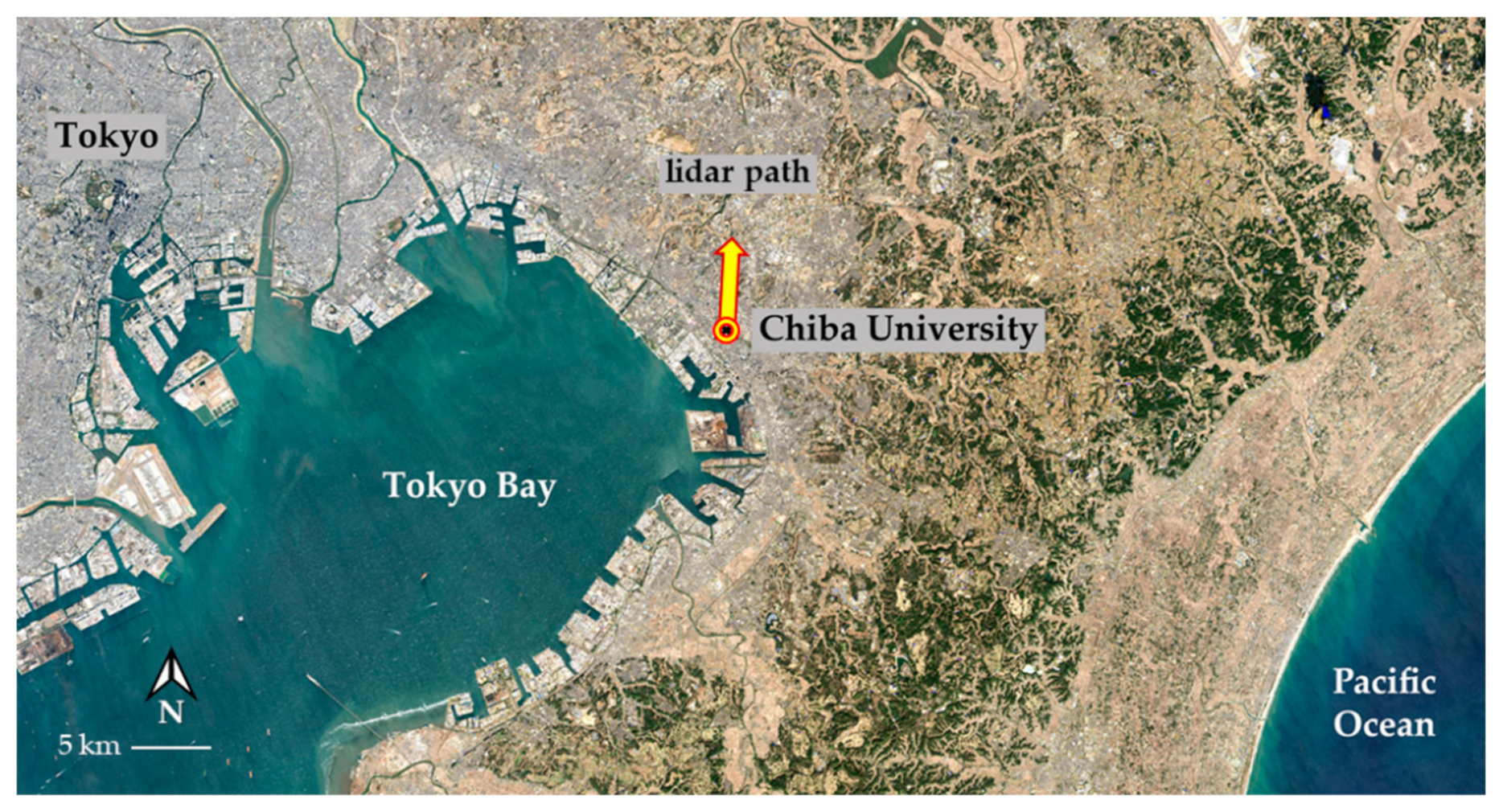
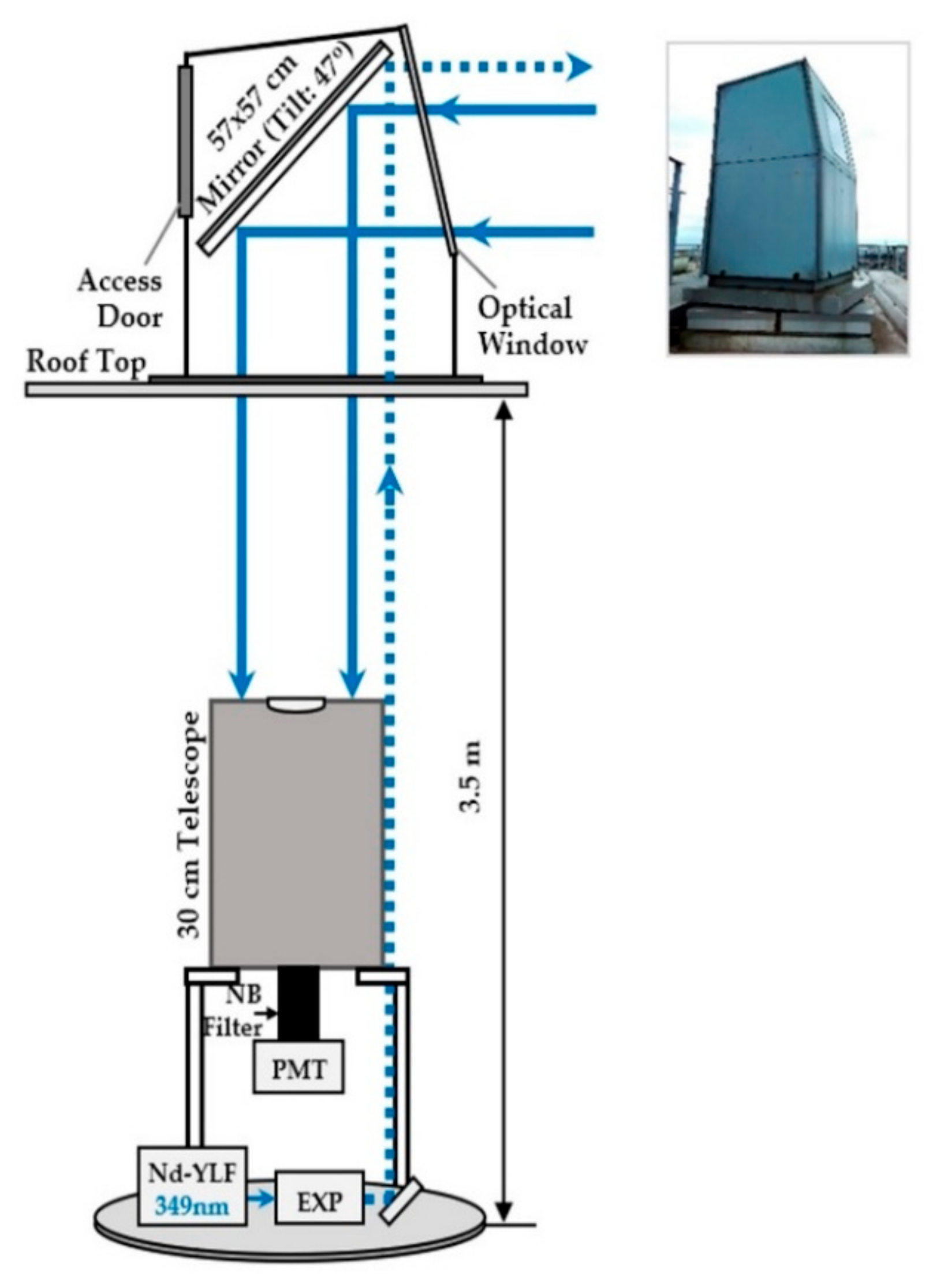
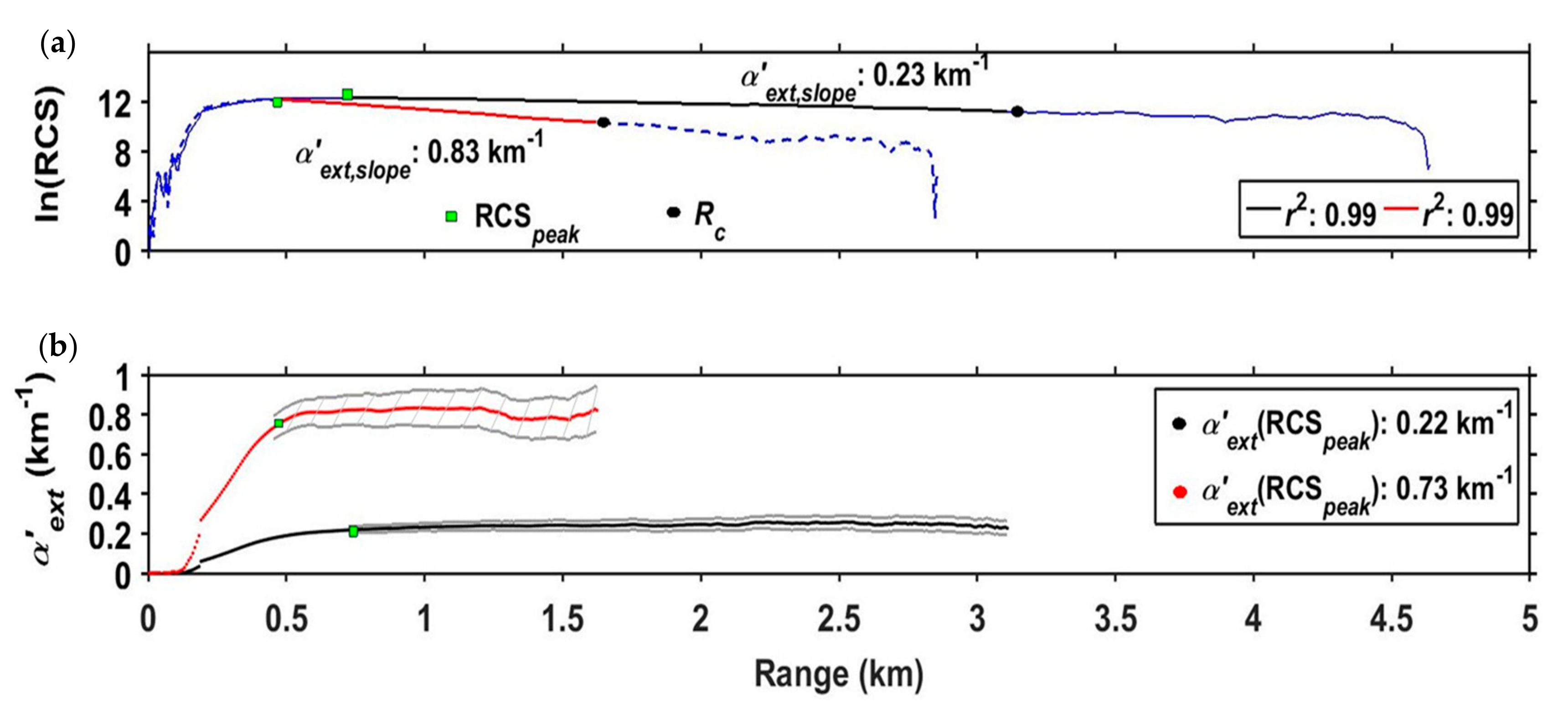
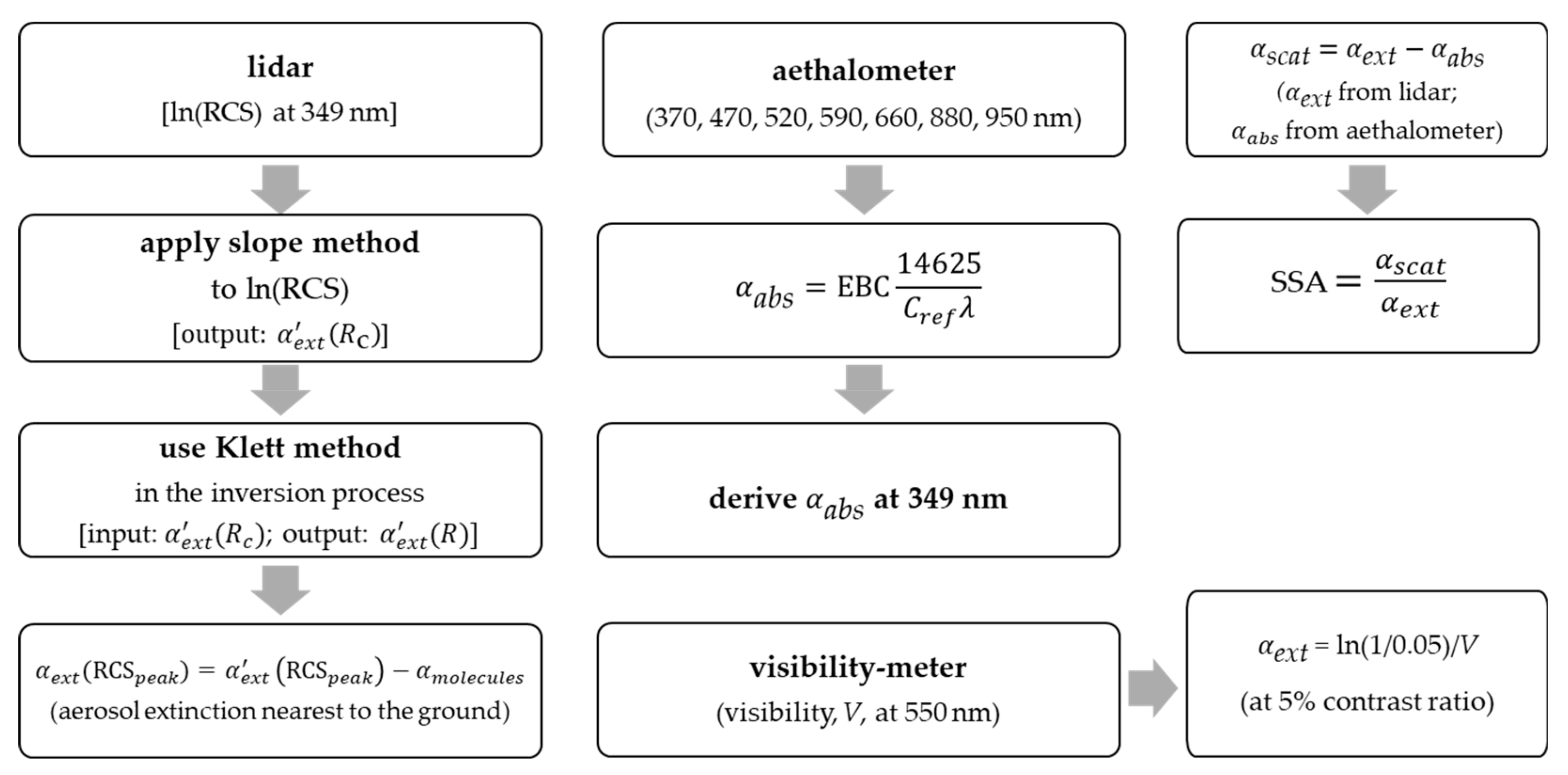
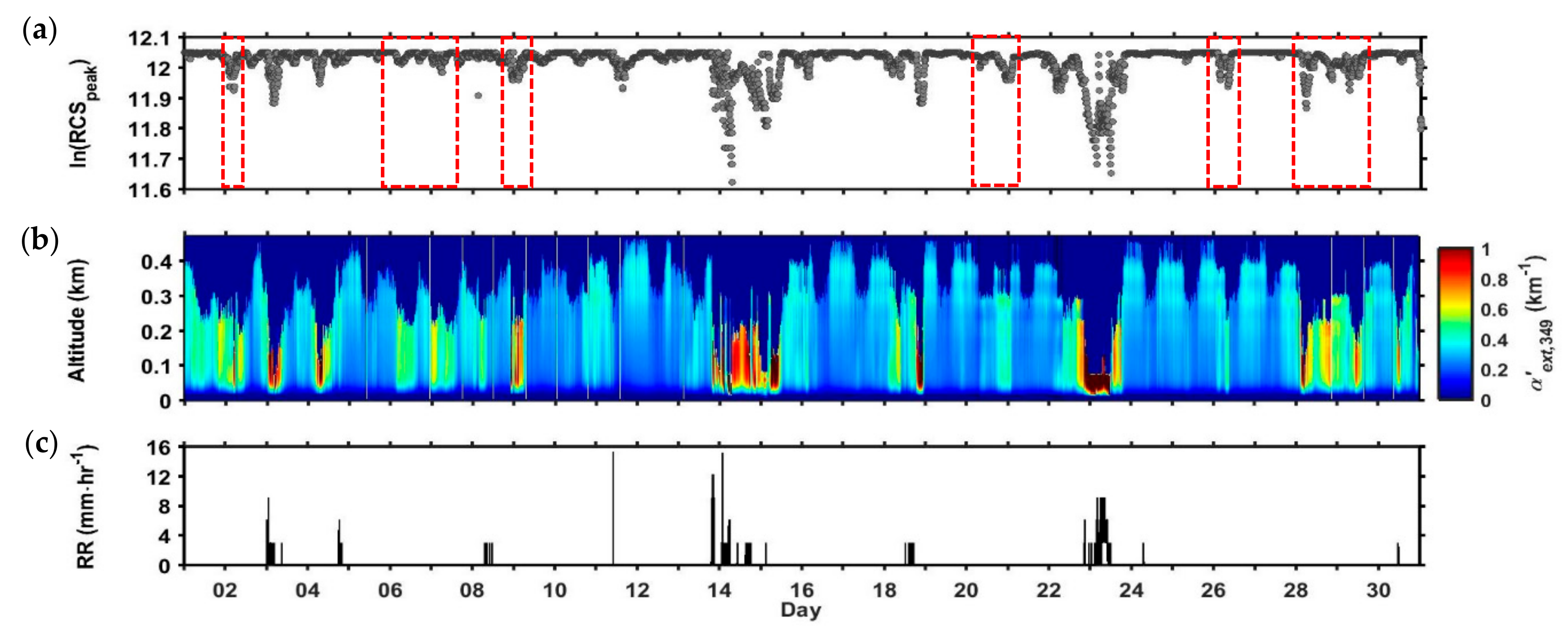
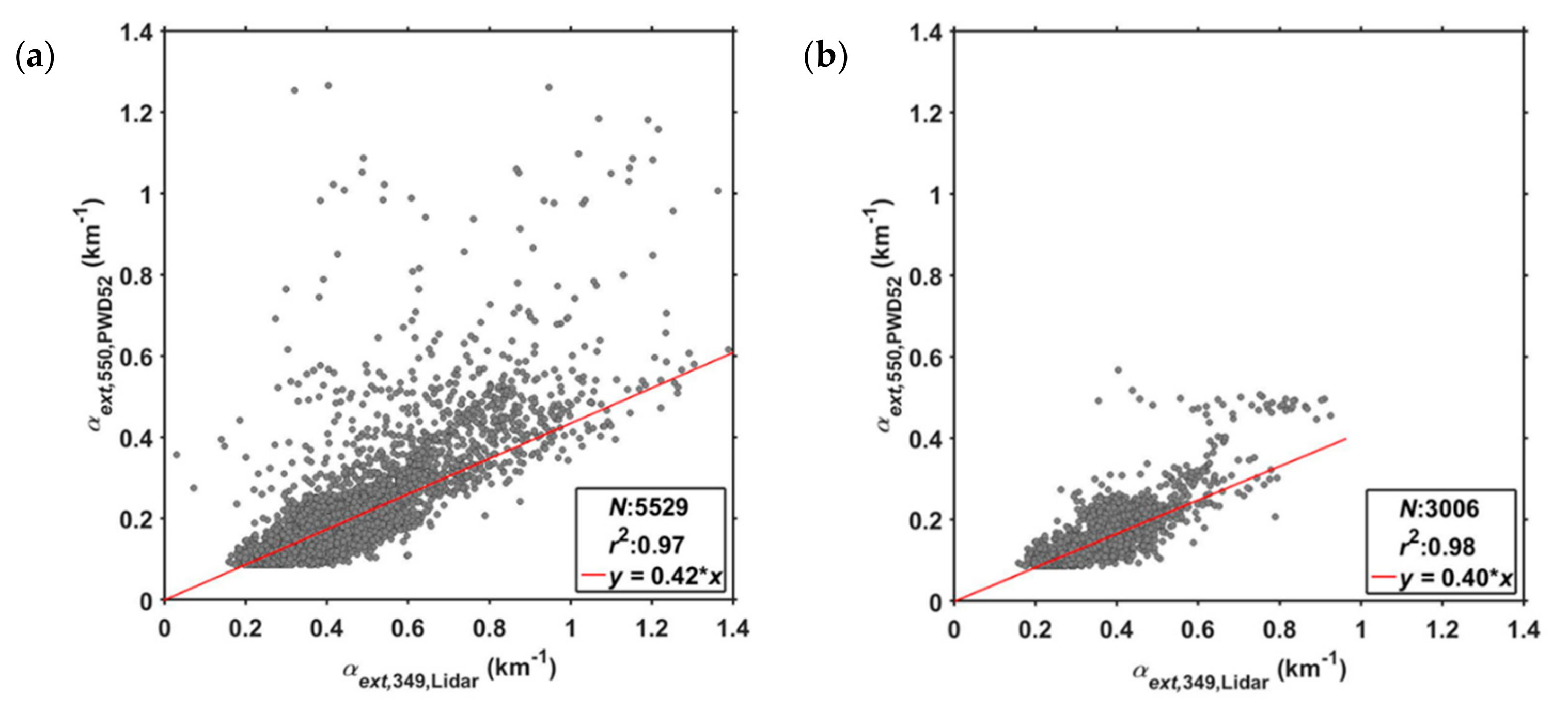
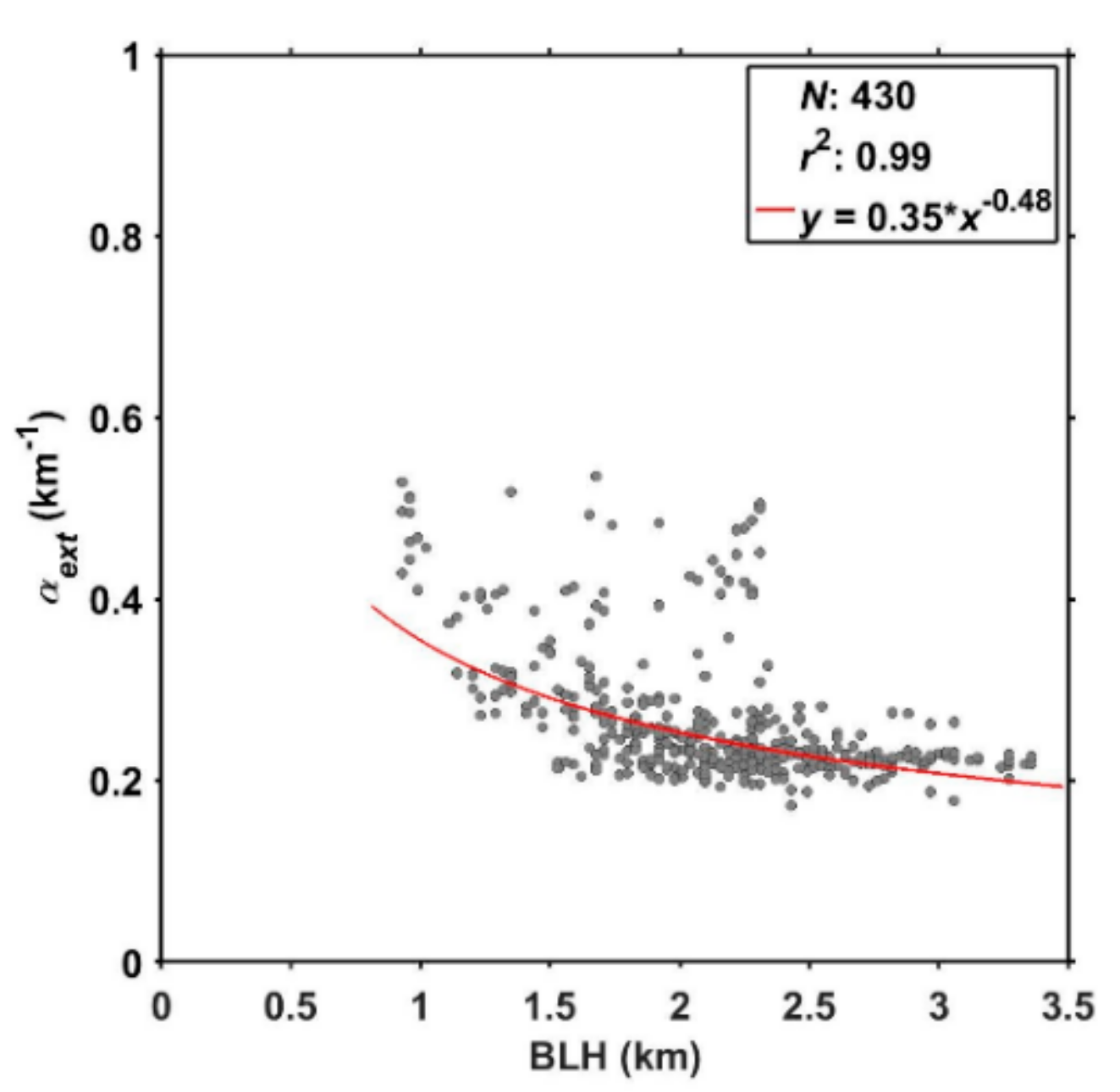
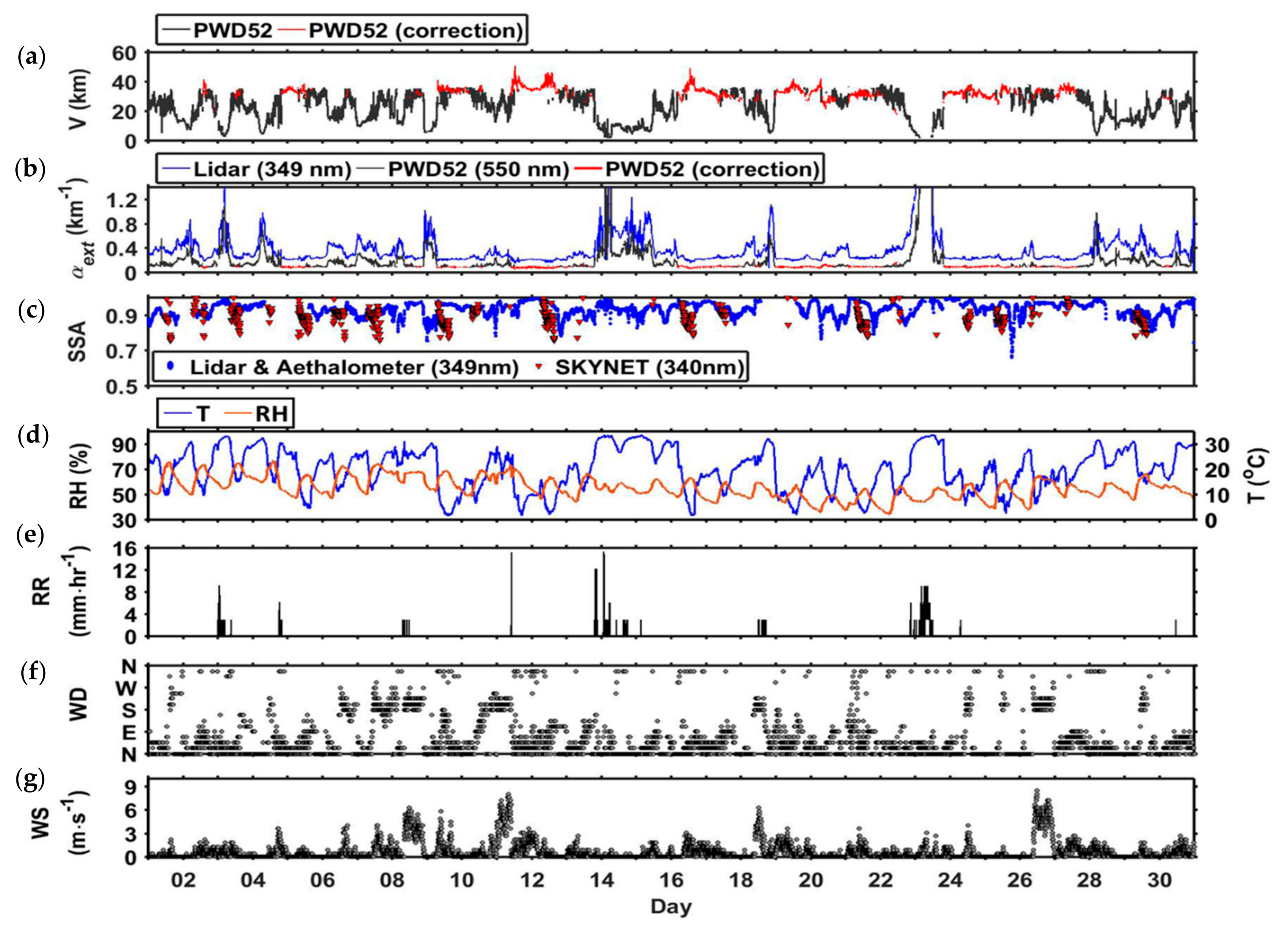
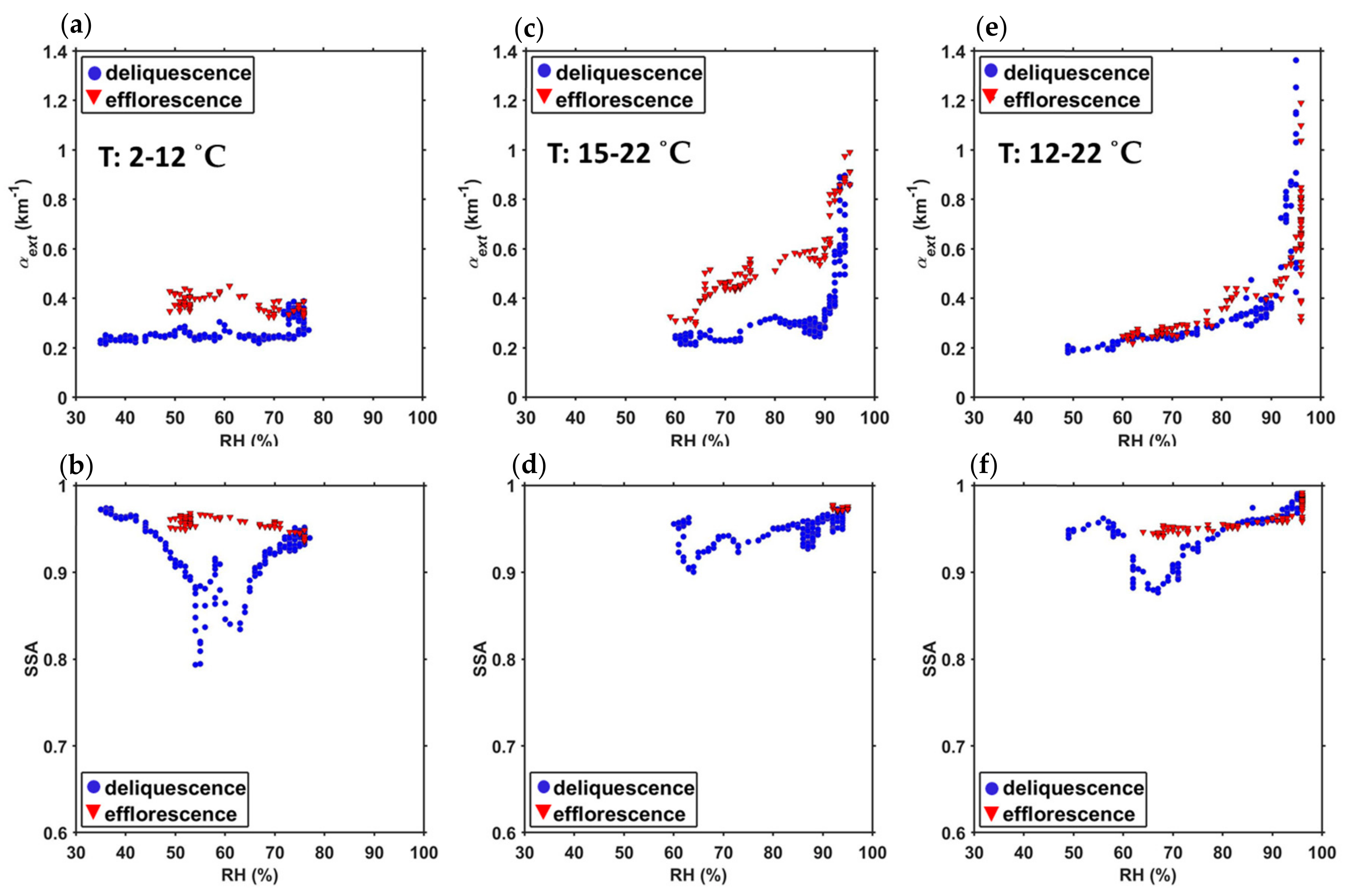
| Transmitter | |
| Laser | Nd:YLF (Spectra Physics, Explorer 349) |
| Wavelength | 349 nm |
| Pulse Repetition Rate | 1 kHz |
| Pulse Energy | 60 ± 7 μJ |
| Receiver | |
| Type | Cassegrain |
| Telescope Diameter | 30 cm |
| PMT Sensor | Hamamatsu (H10304-00NN) |
| Transient Recorder | Licel (TR20-160) |
© 2019 by the authors. Licensee MDPI, Basel, Switzerland. This article is an open access article distributed under the terms and conditions of the Creative Commons Attribution (CC BY) license (http://creativecommons.org/licenses/by/4.0/).
Share and Cite
Ong, P.M.; Lagrosas, N.; Shiina, T.; Kuze, H. Surface Aerosol Properties Studied Using a Near-Horizontal Lidar. Atmosphere 2020, 11, 36. https://doi.org/10.3390/atmos11010036
Ong PM, Lagrosas N, Shiina T, Kuze H. Surface Aerosol Properties Studied Using a Near-Horizontal Lidar. Atmosphere. 2020; 11(1):36. https://doi.org/10.3390/atmos11010036
Chicago/Turabian StyleOng, Prane Mariel, Nofel Lagrosas, Tatsuo Shiina, and Hiroaki Kuze. 2020. "Surface Aerosol Properties Studied Using a Near-Horizontal Lidar" Atmosphere 11, no. 1: 36. https://doi.org/10.3390/atmos11010036
APA StyleOng, P. M., Lagrosas, N., Shiina, T., & Kuze, H. (2020). Surface Aerosol Properties Studied Using a Near-Horizontal Lidar. Atmosphere, 11(1), 36. https://doi.org/10.3390/atmos11010036






